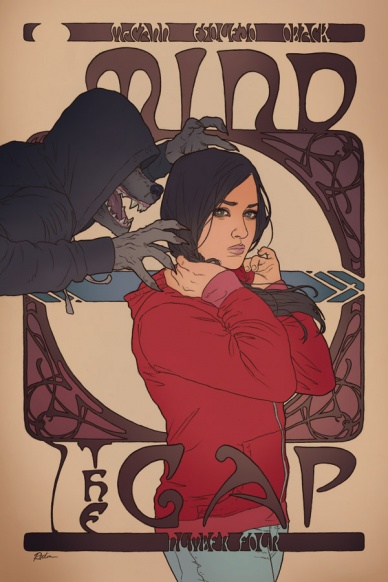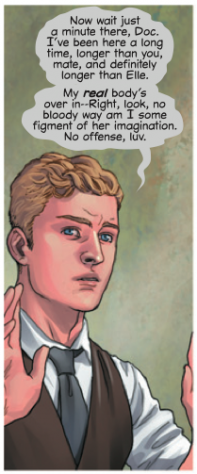Day 2 of our “Mind The Gap” marathon is upon us, and today we hit issue #4: “Big. Bad.” There are wolves and hoods at every corner, and wouldn’t you know it but young Elle is perhaps in a wee bit of danger.
Let’s get to it.
The Title

“Big. Bad.” The title of this issue seems to be three-fold. Let’s discuss how and why.
1. “Big Bad.” A popularized Whedon-sim, the Big Bad refers to the main villain of any given story. It was used in terms towards the over-arcing story of a given season of Buffy, The Vampire Slayer, where the Big Bad would be someone like the Master (season 1) or the Mayor (season 3). In fact, the term “big bad” is used later in the issue by Bobby, when he claims not to be a Big Bad. Even so, is it possible that this issue reveals our master villain? (S/he’s probably here, but no, we don’t know who s/he is.
2. “Big Bad… Wolf.” Popularized from the famous story of three pigs, the Big Bad Wolf huffs, he puffs, and he blows doors down. Of course, the Wolf appears in another fairy tale, that of Little Red Riding Hood. With the cover featuring Elle in a Red Hood, the obvious reference is fairly reference. Of course, what it means is another story — one that doesn’t have any form of easy explanation, truth be told. Is “Mind the Gap” a variation of a fairy tale (like we’ll see on the second page)? Is Elle being hunted? Is her grandmother involved? No idea.
3.” Big.” and “Bad.” Two words, separated by a period. While this is the least potential element for discussion, you can’t help but notice that distinction.
Less Family and Friends
In the cast list for this issue, only Eddie Jr is present amongst the list of Family Members. On top of that, Miles is gone. Could this just indicate that those characters aren’t relevant to the issue? Of course. sot likely, in fact. In fact, if you look at every issue of the series, the cast page shifts based on the issue in question.
And yet, over-eager minds can’t help but notice which characters are referenced in every issue and which ones aren’t. It would seem a possibility that for someone to not get a mention, they may not be one of our hidden villains. (Possibly. Maybe.)
It’s All In Her Head

We’ve theorized this all before, but even though Elle is in some kind space with other people it would seem that the story revolves around her head — her mind. It’s been referenced before back in issue 1, but there is a good deal of conflicting information that seems intentionally laced to seed doubt. As Crenshaw explains, the situation they are currently in does deal very specifically with her and her perceptions, her memory, the reaction to her trauma. That’s as much of a confirmation on something than we’ve ever had.
Of course, we’ve also seen that it’s a shared universe — the Garden. This, what we see, is all in her head — but there are other heads in there. So clearly there is some kind of issue between the two aspects.
For all intents and purposes, we have assumed that Crenshaw was one of the few people who knew what was going on. He seemed to have some advanced knowledge of Elle, to the extent that when he got in an accident he was placed directly with her and knew things about her (I don’t buy his “I saw your name” explanation, because he was out cold). With that in mind, everything that he says is what we’re taking as actual fact. So here’s what he tells us:
1. That the walls, the Memory Walls, are stored data.
2. There are elements of her mind that she is not allowed to have access to, for whatever reason.
3. The closest “real” thing this can be compared to is a Near Death Experience of sorts.
Continued below4. They are seemingly on some “planet of reality between ours and… whatever-if-anything-lies beyond.”
So, the Garden would appear to be some form of the popular belief of Limbo, which is a place that some believe to exist between our life and the afterlife. Everything would appear to check out with popularized elements of genre fiction; the dream-like space traversed by a character in a coma is a rather popular trope, used everywhere from film to concept albums. The questions, then — if Elle is in Limbo — is a) based on the assumption that something was done to her, what was it that allowed her to access this reality and b) if they (the general “they”) are in a shared limbo/reality, what are they all doing their together, especially when some seem to know how it works and others don’t?
And then Elle kicks Bobby and Crenshaw out of her house. She’s clearly got some powerful abilities with her mind.
Building That House
This is a short random thought, but Crenshaw makes reference to Elle taking her “room” and turning it into a home. Just a thought: if Elle allows this space to become a home, is it possible she’ll get stuck there?
Bobby and Frankie

In the column for issue 2, I theorized that there was a deeper connection between Bobby and Frankie due to a set of panels visible in that issue. Elle fades out seeing Frankie, fades in seeing Bobby. It’s a curious sequence, and I immediately noted that Frankie is a character to watch — and wouldn’t you know it, he became important the very next issue with all sorts of aspects about him debated by me.
In this issue, as seen above, Bobby has an interesting line: “My real body’s over in–” and then he cuts himself off. Given all the weirdness about Frankie in the last issue, his believe in “ghosts” and his lack of existence in the first issue — which I’ll say takes him off the table for being at least the attacker/Hoodie — is it possible that Bobby is a mental projection of Frankie? After all, Bobby’s first appearance featured him fading into existence. He doesn’t seem to be like everybody else, as if there’s something unique about his presence within the dreamscape, and with Frankie’s admitted interest in unconventional/non-medical arenas… well.
So let’s keep with the Bobby = Frankie theory for a while, shall we? Heck, let’s take it a step further: who wants to place a bet that Frankie is not only Bobby, but the Big Bad of the story? That he can traverse the dreamscape, but he doesn’t know how to use it and therefore needed to get somebody who was appropriately tinkered with to discover the potential of this world and harness it’s abilities? He does seem rather perturbed that Elle kicks him out of her house.
Theories!
Memories

Once she’s told about the potential of using her memories to help unlock what happened to her, Elle comes to the wall and asks it to help her remember what happened. It shows her that her attacker was on the same train as her, and when the two of them got off the train he attacked her at 50th street. Why that station is abandoned in New York, the busiest city in the world — the city that never sleeps! — is beyond me, but the assumption is that they got off, she recognized him and then he attacked her after having some words.
This doesn’t help us in any easy way to understand, but the important thing to notice is that she can manipulate her memories. The fact that she can zone out all the other people to reveal that her attacker was on the train shows a level of power that seems a touch unbelievable. If she can blot out the world around her to pinpoint one aspect, there is a potential that she has some sort of power that allows her to see reality in different ways.
In fact, it’s entirely possible that that train station wasn’t empty at all.
Or was he never really there? How could she see this person through a crowd, one that she would have no idea existed there before? And in that fourth panel, he isn’t really there anymore.
Continued belowCuriouser and curiouser.
The Case

Hammond arrives at his office to find a case there — one that readers should recognize from issue #2 as the same one Crenshaw had before being attacked. How did it get there, I wonder?
Not only that, but he immediately picks up a phone to talk to the Chief on Line Two. The only problem, as Geller points out, is that the Chief is on vacation. There’s no conceivable way he could be calling!
I don’t think it’s too wrong to assume that this might be whoever is orchestrating all of these events.
Another point of interest from this scene: a few panels before that, Doctor Hammond walks by a man seemingly dressed like him and calls him “sir,” instead of “doctor.” What does that mean? Are we reading into things too much?
The Mystery Caller

Moments before the finale, Geller gets a phone call that seems to hit her pretty hard — to the extent that there’s a panel solely positioned to isolate her from the rest of everything else. Usually in comics, a white borderless panel featuring a solitary character is supposed to represent an important moment, one that represents personal isolation from an environment.
Whoever is calling her is wigging her right out.
You’d assume that this call would be from her wife, but that’s probably not a safe assumption to be made — especially since, no offense to Geller, she’s just as likely a suspect for all the bad things that have happened like anybody else. Just think about how we met her in issue one.
The Lost Child

This arc is coming to a bit of a close, and you should consider this issue the final portion of an episode after the last commercial break. And, as Elle’s story draws to a conclusion, she’s visited by a young girl (whose name we will learn in the next issue) who claims that her body isn’t dead, and she needs Elle’s help to find it.
So here’s the question: how did she know about Elle? Who is talking about her out in the Garden? And is it possible that this girl — and maybe I’m being cynical — isn’t actually real? In fact, if we’re running off my wild Frankie/Bobby theory, could this little girl be Bobby/Frankie trying a new approach, one that is more innocent? Blonde hair, blue eyes… You never know.
The Arrest

The issue closes out with Dane, the boyfriend from the wrong side of the tracks, being arrested due to evidence brought forth by his father. Apparently Dane called and confessed everything, despite him swearing up and down, left and right that he did not do anything to hurt her.
Again, if I hadn’t read the next issue already, I might have some theories to share. But, all things considered, I’ll at least point out that the father is the man called at the end of the last issue, and that all of this seems too convenient. In fact, Dane being arrested at the beginning — to me — is striking evidence that he did not do the deed.
But red herrings exist for a reason. In fact, him getting arrested could purposefully plant a seed of doubt so we stop considering him a suspect, while he secretly is Hoodie. Anything’s possible.







